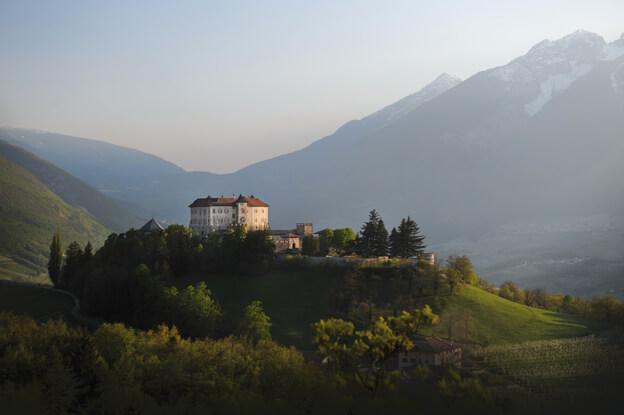We kick off our month dedicated to the region of Trentino-Alto Adige with a feature on some of the top castles to visit in the portion of the region comprising Trentino (we’ll cover Alto Adige in another feature since there are so many).
Shrouded in mystery, the many castles, fortresses and ruins of ancient buildings scattered throughout Trentino are a defining characteristic of the region. This is due to the area’s strategic location between the Germanic lands and the Po Valley, which favored the construction of castles both to control commercial routes through the Alps and as defense against possible invaders.
Some castles are owned by the region and open to the public for visits, while others are still in private hands, although some parts can be visited. Here is a selection of five of the most interesting castles in Trentino.
Castel Thun

In the lower Val di Non, atop a hill at 609 meters of altitude near the village of Vigo di Ton, is one of Trentino’s most precious castles, Castel Thun, whose history is inextricably linked to that of the powerful Tono family, ancient feudal lords who built it in the mid-13th century.
From an architectural standpoint, Castel Thun features three towers with Gothic spires that served to strengthen the heart of the fortification. The fortress develops around this inaccessible nucleus, with massive towers, a large drawbridge, a moat and the walls.
The richly-decorated interiors have been carefully preserved, with original furnishings, such as those you can admire in the bishop’s room, entirely covered with ‘cirmolo’ wood, and thousands of ancient volumes housed in the library tower.
Castel Thun was privately owned and lived in until 1982. It opened to the public in 2010 and has welcomed thousands of visitors since its opening.
Castel Thun is open year round (weekends only during the winter months).
Castel Pergine

Perched on a hill overlooking the Via Claudia Augusta in the upper Valsugana, Castel Pergine was built in the 13th century and is one of the best examples of medieval architecture in the Alpine region. It is believed that it was constructed over a pre-existing building used by the Lombards. It was later owned by the dukes of Austria before it passed on to the prince-bishops of Trento.
The castle has undergone few changes over the centuries. Around 1900, it was acquired by a German company which converted it into a restaurant and hotel. The ground and first floors are accessible to the public. Among the highlights are the Camera del Camino, where, according to legend, a mysterious white lady regularly makes an appearance, and the Sant’Andrea chapel on the first floor. The five halls on the second floor host various exhibitions.
Castel Pergine is closed in the winter months. It will reopen on April 7, 2017.
Castello di Rovereto

Standing tall and imposing on a cliff on the right bank of the river Leno, where it enters the Adige valley, the Castle of Rovereto was built in the 14th century. Its current structure, as well as the walkways, the towers, the spur, the bastion and moat are the work of the Venetians, who occupied it in 1426, and transformed it into one of the best examples of late medieval Alpine fortification. It is a unique example of Venetian fortress in Trentino.
Through the centuries, it was used as military barracks and as a prison. After suffering damage during the First World War, it was restored and today it houses the Italian Historical War Museum, one of the most significant in Italy dedicated to World War I.
The castle and museum are open year-round.
Castel Toblino

Perhaps for its enchanting position on the shores of Lake Toblino, perhaps for the numerous legends and forbidden love stories that are said to have taken place here, Castel Toblino is a favorite with romantic souls.
A rare example of a castle by the lake, the building originated from an ancient temple dedicated to the worship of the Fates. The fortification as we see it today is the result of the restructuring carried out in the 16th century. It was a favorite summer residence of the prince-bishops of Trento.
According to one of the legends associated with the castle, Toblino was the site of a forbidden love story that involved a bishop who tried, in vain, to obtain the dissolution of priestly vows in order to be with his beloved (who eventually drowned in the lake). Another story sees another thwarted love between a Toblino lord and a beautiful castle dweller in nearby Stenico. The lord ended up being killed by his love rival as he was riding his horse back to the castle.
Today, Castel Toblino houses a restaurant and it is only open to patrons.
Castello del Buonconsiglio

Castello del Buonconsiglio is Trentino’s most important castle, the ancient residence of the Prince Bishops of Trento and a landmark of the city. Today, the castle, located in a slightly elevated position above the town, houses a museum hosting important exhibitions.
The castle comprises architectural and decorative elements from different eras. The older section comprises the aptly named Castelvecchio (old castle), the first building erected in the 13th century next to the city's walls, and Torre Aquila (Eagle Tower), which features a cycle of Gothic frescoes, Ciclo dei Mesi, providing a glimpse into the rural and social life of the area at the end of the 14th century. A richly-decorated area known as Magno Palazzo dates back to the Renaissance, while another wing of the building, the Giunta Albertiana, is Baroque.
According to legend, the castle was connected by a secret tunnel to the city's cathedral, which allowed the prince-bishops to move unseen between them. The castle remained the seat of the Prince-Bishops until 1803 and represented at all times the heart of the city.
The complex now houses the Museo Provinciale d’Arte, a regional museum of art.
Castello del Buonconsiglio is open year round.




